The Meizu MX4 Pro Review
by Andrei Frumusanu on February 16, 2015 2:00 AM EST- Posted in
- Smartphones
- Exynos
- Mobile
- Meizu
Display Measurement
The Meizu MX4 Pro comes with a 5.46" JDI manufactured LCD. What differs from most other LCD panels that we've seen in mobile devices is that Meizu employs a much more precise backlight LED driver IC that is able to provide 2048 levels of brightness. Although this doesn't really affect everyday usage and such brightness resolution is not needed, it's the way that Meizu decides to use this in the lower brightness levels that really marks a departure from any other vendor.
Before getting into details of the low brightness performance, we'll look at the maximum luminance the display is able to achieve. As always, our display testing is done with an X-Rite i1Pro 2 as our measurement hardware, in conjunction with SpectraCal's CalMAN software suite and our own workflow to be able to get an accurate display characterization.
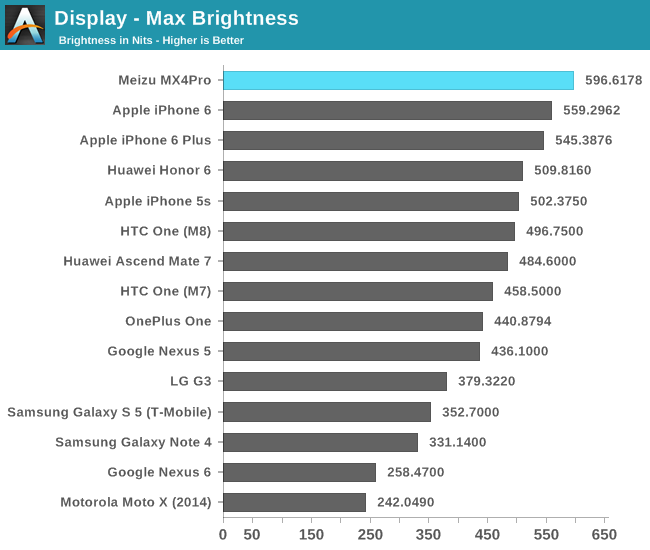
The Meizu MX4 Pro manages to dominate the brightness chart at 596 cd/m². This is easily one of the brightest devices we've tested, outperforming even Apple's iPhones. People who paid attention to Meizu's marketing materials will notice that they only proclaim a maximum brightness of 450 cd/m², and indeed my initial measurement when I received this review unit came in at a lower 484 cd/m². The increased brightness came only after I had updated the device to the 4.1l firmware, which unlocked the brightness slider to the maximum hardware brightness settings.

The black levels at maximum brightness remain quite high, providing one of the weakest performances among competing devices. Fortunately this happens only at maximum brightness as lower brightness settings such as at 200 cd/m² will achieve 0.1543 nits on black.
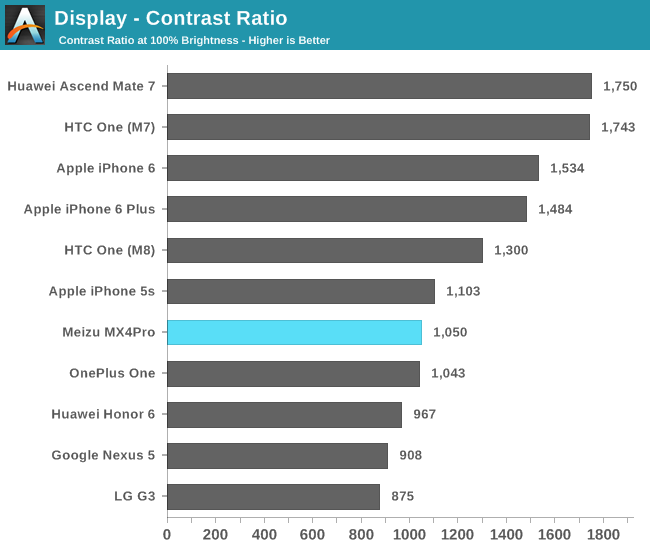
Due to the high black luminance at 100% brightness the Meizu achieves only a 1050:1 contrast ratio. Again, this only happens at maximum brightness as more normal use-cases such as our 200 nit measurement level will achieve a 1300:1 contrast ratio.
I've mentioned in the introduction that the screen is able to achieve excellent low-light brightness conditions, but nothing really prepared me for what I discovered. The MX4 Pro is able to achieve 2.7 cd/m² under the manual minimum brightness setting that is exposed via the brightness slider. This puts the Meizu at similar excellent low-light emission levels as Samsung's recent AMOLED devices such as the Galaxy S5 and the Note 4. Not only was this LCD screen able to match those the low brightness of Samsung's devices, but it managed to do it while retaining color accuracy and especially color resolution as dark grays would not suffer from the same black clipping that the recent AMOLED devices are displaying.
I specified that the 2.7 nits on the MX4 Pro was achieved with the minimum brightness slider because the actual hardware is capable of much lower settings. One might remember that Meizu markets the 2048 brightness levels of the display, however the lower 500 levels are not achievable under normal circumstances unless one goes to edit the brightness manually in the control entry of the back-light driver. Here actually setting the minimal brightness as allowed by the hardware achieves an insane 0.17 cd/m² on whites. For comparison, I took a long-exposure picture of the MX4 Pro next to the Note 4 at both their minimal allowed luminance, as seen on the left side of the picture. What really astounded me here is that the MX4 Pro remained absolutely color accurate even at this crazy low setting, as visible in the 50 second (!!) exposure of the phone on the far right.
Although going so low in brightness serves absolutely no practical use, as even in a completely dark room you will have a hard time reading content, it does prove that there is no technological barrier in LCD screens preventing manufacturers from implementing comfortable low brightness levels for reading at night. I appreciate Meizu for being one of the first manufacturers to actually allow this on LCD screens and I hope we'll be seeing wider adoption in the future.
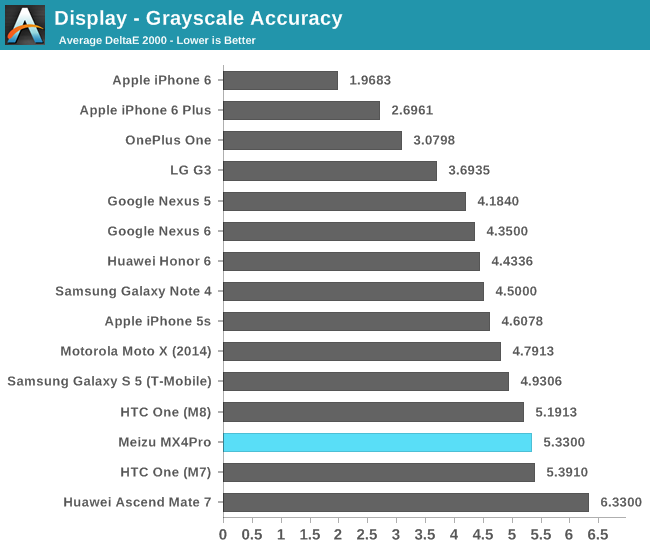
The grayscale accuracy lands at a deltaE2000 of 5.33, which represents a figure above the generally noticeable threshold of 3. The JDI screen seems to be calibrated for a cool color temperature target of 7400K, making the screen have a blueish tint on whites. There is unfortunately no setting to change the configuration of the screen.
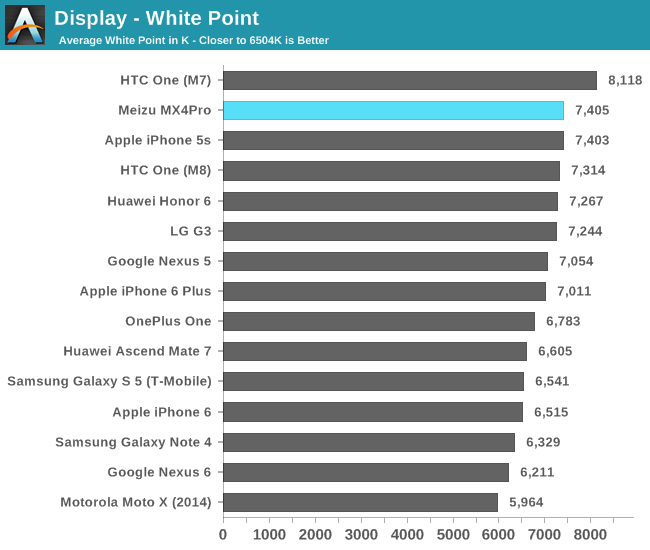

It's on the saturation accuracy where the Meizu sadly disappoints. The hue is off in the yellow and magenta spectrum, and all saturations beyond 80% suffer from significant compression. Colors are much too bright and have the radioactive look that people are familiar with on Samsung's AdobeRGB colorspace screen modes.

Due to the strong saturation compression and cold color temperature, the Gretag Macbeth color accuracy chart and deltaE2000 achieve only a disappointing figure of 4.98. This is considerably worse than other competing devices, with only the One M8 and Motorola's uncalibrated AMOLED devices performing worse.
Although the MX4 Pro impressed with its brightness, excellent sharpness, and outstanding low-light performance, it simply cannot be advised for people who appreciate color accuracy. For people who are looking for a "vibrant" and otherwise excellent display in all other aspects besides accuracy, I'm sure the Meizu MX4 Pro will more than satisfy.
Display Power
The detailed display power curve of the Note 4's AMOLED screen is something I want to translate to LCD screens too whenever I have the opportunity. The MX4 Pro's screen luminance rises exponentially to the actual brightness level of the backlight, which does have a noticeable effect on battery life tests that rely on standardized percentages rather than standard luminance.
The device power goes from from about 530mW at minimal brightness, up to 1.69W at the maximum 597 nits. Power seems to scale linearly with the luminance, meaning there should be no efficiency penalty of running the higher brightness levels. LCD screens remain the most efficient technology for high brightness mobile displays, as the break-even point for current generation AMOLEDs looks to lie at around 65% APL when displaying white content.
I couldn't measure any power difference when measuring various APL levels on the MX4 Pro, meaning that the power to drive the LCD matrix itself is negligible. It is to be mentioned that due to this being a QHD display, it suffers from the same MIPI-DSI bandwidth limitations as other 1440p smartphones, meaning the physical bandwidth of the D-PHY interface between the SoC's display controller and the display driver IC is not enough to drive the full resolution at 60fps. The Meizu MX4 Pro, much like other Exynos SoCs and the Galaxy Note 4 Exynos, is able to circumvent this limitation with help of MIC (Mobile Image Compression), enabling the phone to make due with just 4 MIPI DSI lanes and thus allowing for better power consumption in dynamic content, on top of what PSR (Panel Self Refresh) offers for static content.
With a good idea of what the screen's power and luminance characteristics are, let's continue on to the battery life tests of the MX4 Pro.


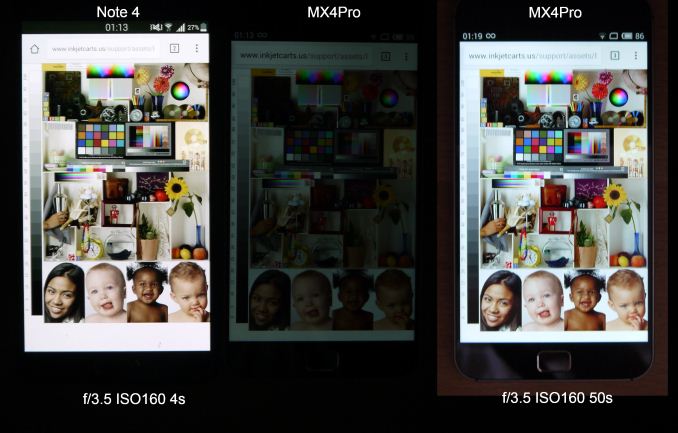
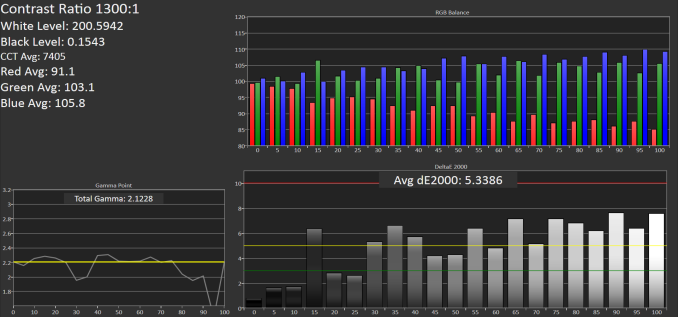
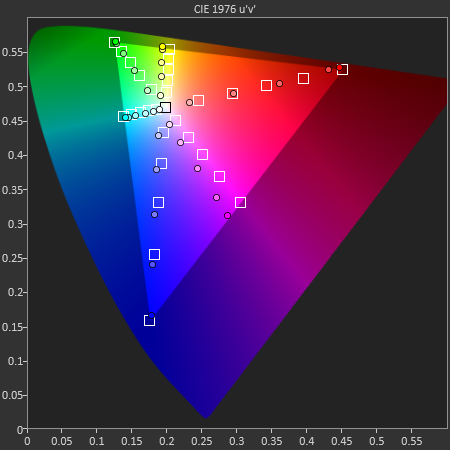

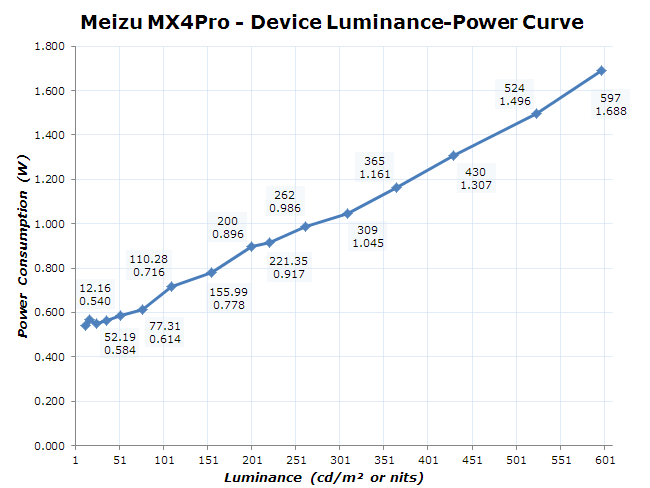








70 Comments
View All Comments
olafgarten - Monday, February 16, 2015 - link
This looks like an iSamsung.jameskatt - Monday, February 16, 2015 - link
This is why Samsung is in deep trouble. Bottom feeders like Meizu can simply copy Samsung's designs and sell more phones, killing Samsung's own opportunity to sell phones.sonny73n - Tuesday, February 17, 2015 - link
Copy Samesung designs? Lol. Don't you even know all smartphones are rectangle with touchscreen and volume buttons? The only theft I know stealing designs from Apple is Samsung. Funny that they had pictures of the iPhone designs side by side with theirs with arrows and marks and notes showing how to. Then the whole thing leaked out and Samesung got their arses sued off. I couldn't stop laughing when I saw those pictures. Google it.Samesung design is ugly. They keep releasing the same old ugly thing over and over, protruding camera and speaker on the back, only in different sizes. Lol. Then they call it new and slap a premium price on it. Low specs and high price on the same ugly thing lol.
Oh! Didn't you know they cheated in benchmarks? Lol. So lame. I can't wait for those cheating crooks hit the dumps.
TT Masterzz - Monday, February 16, 2015 - link
Nice to see AT reviewing devices primarily sold in Asia. On a side note why don't you guys review Xiaomi devices. Xiaomi is much bigger than Meizu. They are the largest in China and some of their smartphones are amongst the top 10 most sold smartphones in the world. Would love to see a review of Mi Note Pro for example.Pissedoffyouth - Monday, February 16, 2015 - link
I'd like them to do even less known ones, like ThL phones or similar.jjj - Monday, February 16, 2015 - link
It is the second cheapest 1440p (or about that in this case) phone on the market at China prices (2499CNY/400$) after the Iuni U3 but maybe the MX 4 is more interesting since it's 20% cheaper and the most interesting Meizu is the m1 Note since it's one of the first to define the new 2015 midrange (5.5 inch 108p, 8xA53 , 2GB RAM at 160$).As for the lack of microSD, they have an Apple fetish they have a hard time doing better so the Meizu m1 is their first device with one, all previous models don't have it.
But Meizu is a name to watch this year, by my estimates they sold 6.5-7.5 million units last year but they changed strategy and instead of one device per year now they are playing in a bunch of price bands. So they'll have fantastic growth this year ,they'll easily hit 20 million units but in an ideal scenario they could even get close to 40 million units. They are trying to catch Xiaomi (Xiaomi went from 1 model to a few earlier) and they might get there in 2-3 years.
Hard to say if they have the intelligence, creativity, instinct to do more and actually make a difference but we shall see.
Oh and ofc hopefully they'll get the Exynos 7420 or better in their next flagship since Meizu always goes Samsung (the only significant external win for Exynos so far) so their next flagship could be one of the few devices faster than most other flagships that are by default SD810 based.
jjj - Monday, February 16, 2015 - link
Also too bad you can't test LTE, was curious how Marvell does, they usually do a got job in everything (HDD controller, SSD controller, networking) but in mobile they had some tough years with the Blackberry decline.Andrei Frumusanu - Monday, February 16, 2015 - link
Like I said it does pretty well in subjective testing. I just need to get more Qualcomm devices and I'll do a proper comparison of all of them in the future.jjj - Monday, February 16, 2015 - link
Maybe AT could do a dedicated article on LTE with Qualcomm , Marvell , Mediatek , Intel ,Hisilicon. Icera.Gemuk - Monday, February 16, 2015 - link
Sad indeed that 8xA53 is considered midrange nowadays. Agree though that the m1 Note should do well, at least until Xiaomi releases the Redmi Note 2 (if there is one)